Description
There are few customs as quintessentially English as afternoon tea. From being the preserve of the privileged classes, to the universally enjoyed and infinitely varied occasion that it is today, afternoon tea is loved and appreciated all over the world. In Queen Elizabeth II’s Platinum Jubilee year, it seems fitting that a tradition which was popularised by a previous queen of England and a duchess should be celebrated with the publication of a wonderful new book on the subject.
In Please pass the scones: a social history of English afternoon tea, social historian and author Gillian Perry takes us on a highly entertaining whistle-stop tour, enhanced by many luscious illustrations to make you salivate, and to bring forth your own wonderful memories. The book covers many aspects of the afternoon tea story, including its origins, etiquette, dress codes, and the rise and fall of once-essential tea table features such as the slop bowl and the paper doily.
The precise elements that make up an afternoon tea may vary – fine crockery, silver spoons, a traditional three-tiered cake stand or a thoroughly modern alternative, delicate sandwiches, party themes, miniature sweets, fizz. But there are two things that cannot be omitted: a steaming pot of the flavoursome liquid that all the delicious edible treats pivot around, and a fresh, scrumptious scone.
How do you make the optimum cup of tea?
What height should the perfect filled scone be, and is it jam or cream first?
What is the tea-related origin of the expression ‘the dregs of society’?
Why were tea gowns frowned upon in Victorian society?
Gillian Perry answers these and hundreds of other questions in a story that involves smuggling and scandal as much as refinement and high society. Her style is readable, amusing and informative, in this beautifully produced, unique book that will be a perfect gift for someone special in Platinum Jubilee year.
- Author: Gillian Perry
- Publication Date: 21/04/2022
- ISBN:978-1-910837-40-5
- Binding: paperback
- Format: 240 x 170 mm
- Extent: 192 pages
- Illustrations: 100

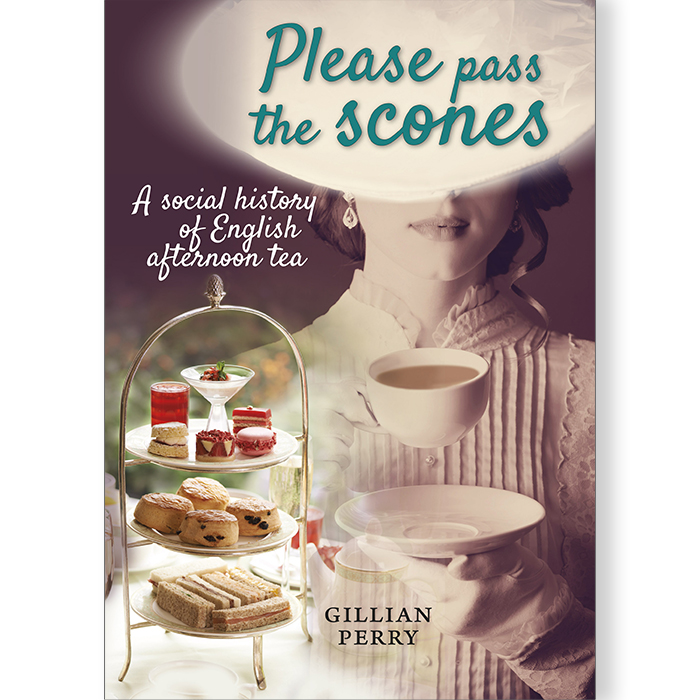
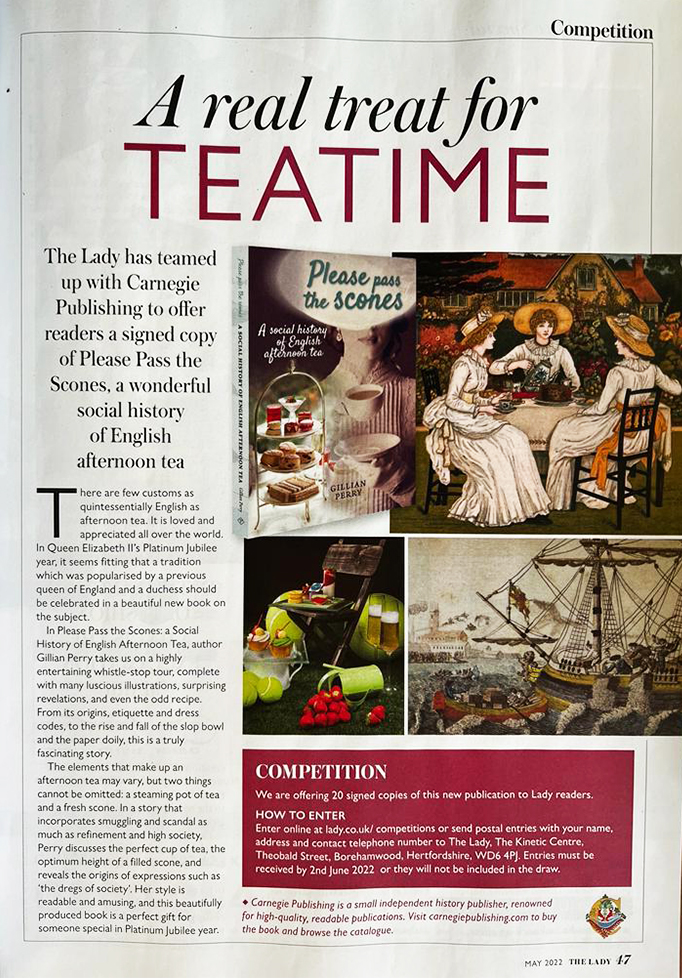
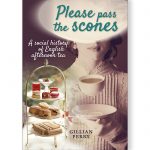
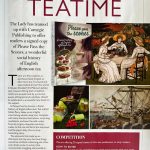
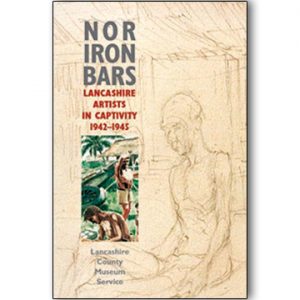

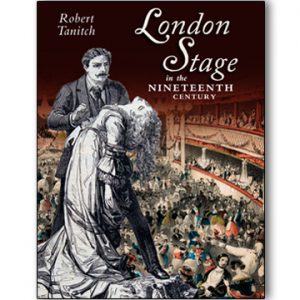
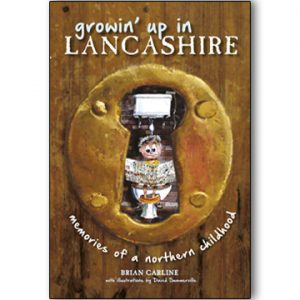

The Lady –
There are few customs as quintessentially English as afternoon tea. It is loved and appreciated all over the world. In Queen Elizabeth II’s Platinum Jubilee year, it seems fitting that a tradition which was popularised by a previous queen of England and a duchess should be celebrated in a beautiful new book on the subject.
In Please Pass the Scones: a Social History of English Afternoon tea, author Gillian Perry takes us on a highly entertaining whistle-stop tour, complete with many luscious illustrations, surprising revelations, and even the odd recipe. From its origins, etiquette and dress codes, to the rise and fall of the slop bowl and the paper doily, this is a truly fascinating story.
The elements that make up an afternoon tea may vary, but two things cannot be omitted: a steaming pot of tea and a fresh scone. In a story that incorporates smuggling and scandal as much as refinement and high society, Perry discusses the perfect cup of tea, the optimum height of a filled scone, and reveals the origins of expressions such as ‘the dregs of society’. Her style is readable and amusing, and this beautifully produced book is a perfect gift for someone special in Platinum Jubilee year.
Louise Walters –
See Louise Walters’s review in Jewish News.
Milk first or tea first? Jam first or cream first? Earl Grey or English breakfast? The quintessentially English tradition of afternoon tea poses many questions, but the one I most want the answer to is this: what’s the michigas about bridge rolls?
I asked social historian Gillian Perry MBE, author of the Pass the Scones, A Social History of Afternoon Tea, and she was baffled. She duly went off to ask Debbie née Grodzinski, who told her that the bridge roll, which was first seen in 1926 and was popular for children’s tea parties, is mezanot, meaning that it is defined as cake rather than bread, and therefore in Orthodox circles does not require the washing of hands prior to consumption. The reason we all love bridge rolls is that they are sweeter than sandwiches, and that is because the dough is made with fruit juice rather than water, which is what renders it cake.
Gillian founded and for 26 years ran The Anne Frank Trust UK, an educational charity. When she retired in 2016 she still wanted to be involved in education so she embarked on a new career as a speaker and lecturer. She approached a cruise company with the offer to give on-board lectures about Anne Frank and they asked whether she had any additional subjects to talk on so that there would be a varied programme for the passengers. She thought about what she was interested in and decided to research the history and customs of afternoon tea. “Not only is it a tradition that has survived for hundreds of years, it is also enjoying a huge revival, much of which can be credited to the Bake Off series” she says. “Afternoon tea has a great sense of nostalgia attached to it, and it’s something special and uplifting – not something that you have every day.”
Gillian’s quest took her to many of Britain’s beautiful historic houses and hotels and she enjoyed afternoon tea in the finest, quirkiest and most interesting of locations. Armed with her newfound knowledge, Gillian has lectured at sea, on land and in venues as wide ranging as JW3, the IOD and private homes. During lockdown she decided to write a book, which is not only an enlightening read, but also a great gift.
Tea was first discovered in China 5,000 years ago when a few leaves from a bush fell into Emperor Shen Nungs’ boiled water. He loved the taste and is credited with pioneering the drinking of tea as we know it today. By the 1600s it had made its way to the UK, and in 1662, when the new Queen Catherine arrived from Portugal, she brought trunks of tea as part of her dowry and it soon became the official court beverage.
The tradition of afternoon tea as a meal came about in the 1840s, when the Duchess of Bedford found that she was getting hungry at home in Woburn Abbey in the long hours that stretched between her midday lunch and the evening meal, which was served fashionably late around 8.30 pm. She asked her maid to bring her some light refreshments at 4pm: “Perhaps a few triangles of bread, butter and jam, and a couple of small biscuits”. As part of her research for her book, Gillian was as invited to Woburn Abbey. “Imagine my excitement at being in the very room where the Duchess’ first experience of afternoon tea was taken,” she says.
The Duchess began to invite her friends to join her for this repast, and so the practice made its way into the drawing rooms of the aristocracy and then to Queen Victoria. She introduced the ritual at court and soon all of society was drinking tea and eating sandwiches and cakes in the afternoon. “Cakes tended to be solid and heavy at that time. The invention of baking powder allowed them to rise and be airy and Queen Victoria’s love a of certain simple light airy sponge cake spread with jam led to it being named after her,” says Gillian.
She goes on to explain the difference between afternoon tea and high tea. “High tea describes a more substantial meal that workers came home to, having foregone a sustaining meal at lunchtime. It was served at the later ie ‘high’ point of the afternoon. It also applied to an evening meal in public venues where they sat at high stools at a counter rather than being waited on at tables as the more affluent were. Today Afternoon Tea is often referred to as High Tea in other parts of the world, especially the US.”
Milk was not commonly drunk with tea in Britain until the 1720s, when black tea overtook green tea in popularity. “In the early days, poorer quality cups could crack when hot tea was poured in so putting milk in first prevented this. Putting it in last was a way of showing that you had the best quality china,” says Gillian.
In the 1860s, tea rooms started to spring up in the UK. “This was an exciting development for ladies, as they could meet their friends in a public setting without being escorted by their husbands and without risking damage to their reputation,” says Gillian. The Aerated Bread Company opened its first ABC tea shop in 1864 and by 1923 had 250 branches. There were considered a little downmarket and J Lyons opened up a more genteel alternative, which was also better run. The staff were known as nippies, which implied speed and efficiency. “At one talk a gave a lady proudly told me that her mother had been a Lyons nippy”, says Gillian.
Whether you pronounce scone to rhyme with gone, stone or even scoon (largely dependent on where you live), the pressing debate is about the cream/jam order. Devon claims cream first, Cornwall jam first. “I find that people generally stick with the Cornwall method, as aesthetically the red jam breaks up the beige of the scone and the white of the cream,” says Gillian, who tells me that she prefers a prefer a sharp jam like blackcurrant and a small scone without raisins.
In the ‘anything goes’ 21st century, afternoon tea comes in many guises. As well as the traditional afternoon tea found in hotels, teashops and cafes there as also themed teas, savoury teas, vegan teas, doggy-friendly teas and Indian, Chinese and Japanese restaurants have also developed their spin on afternoon tea. One the most innovative I have come across is a Tipsy Tea that my daughter took me to on Mother’s Day where the teapot is filled with a cocktail rather than a brew. Afternoon tea is increasingly popular for celebrations at home and caterers have come up with ever more creative ways of doing this. Karen Harris Catering sets up a grazing table beautifully decorated with flowers and plants, with dishes and plates of tea-time nibbles all at different heights. Gillian is often booked to speak at celebration teas.
Smoked salmon is a key feature of afternoon tea. It was introduced to the UK by eastern European Jewish immigrants fleeing the pogroms. Salmon was plentiful n their rivers and they smoked it as a way of preserving it. Once settled in the UK they started importing Baltic salmon until Aaron ‘Harry’ Forman started curing Scottish salmon. It was he who convinced culinary establishments that it was a delicacy and that’s how it found its way on to the three-tiered tea stand. This brings me to my next question: why a tiered stand? “I have no idea, says Gillian. “Perhaps the low tables were too small to carry the increasing number of delicacies that ladies wanted to consume with their ‘low’ ie ‘afternoon’ tea. I will have to do some research.”
I shall enjoy her findings with a cuppa.